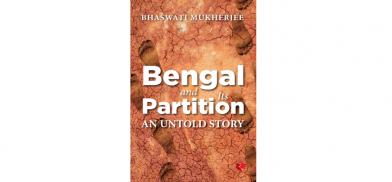A connoisseur's ode to Bengal
If we go by the public perception, it seems the horrors of this partition had visited only our western side. The fact that people in the east suffered, almost as much, is not as well known

Even after 75 years, India and Pakistan have been unable to come to a closure on the Partition of 1947. In the east, however, Delhi and Dhaka are busy finding ways for greater cooperation. This is one among many differences in the way the amputations in the east and west of India has shaped up.
If we go by the public perception, it seems the horrors of this partition had visited only our western side. The fact that people in the east suffered, almost as much, is not as well known. Ambassador Bhaswati Mukherjee fills this gap with her sensitively written book “Bengal & its Partition: An Untold Story (Rupa).”
Speaking of many differences, take for example the scene at sunset on the Wagah-Attari border.
Every evening military boots try to stamp out the ground below their feet. All this, as cheering hordes egg them on to take their feet higher and higher still for an even louder bang. In the few minutes that the ceremony and the accompanying cacophony lasts, the noise shakes up the surrounding area. The attending public returns home with a sense of pride that they, and their military men, outdid the rivals from the other side.
Some call it catharsis; a way of healing the wounds of partition.
Division of Bengal
But skeptics wonder why it is necessary only on the Indo-Pak side. After all people bled in Bengal as well; they too suffered the pain of displacement. Yet there are no frenzied scenes at border posts there; no war-like cries by rival mobs, nor the stomping of military boots. Why are the evenings so placid on the Indo-Bangladesh border, as if 1947 had not happened there?
Let’s take another difference. In north India people talk nostalgically of the food on the other side; the niharis and kadai chickens of Lahore. One rarely hears of a past left behind in Sindh, Balochistan, or KPK. No one ever mentions the deeper roots abandoned in Mohenjo-daro and Harappa.
The case of Bengal is completely different. Instead of venom, there is regret that an unjust hand should have sliced them so. It is the roots that their angst is about. Their regret too is tinged with nostalgia; but it is about the culture and the way of life on the other side. This longing for fusion is what Bhaswati Mukherjee’s book is about. She starts from the beginning tracing patiently a shared way of life in the glory that was united Bengal. She digs deep into Bengal’s past as she writes;
“In this fertile delta of the Ganges, the diverse influences that developed into syncretic values included Buddhism, Hinduism, Sufism, and Tantric cultures… These multiple religious identities permeated all levels of society. It also influenced the evolution of a distinct Bengali Islamic Culture. From mutual accommodation and absorption a tolerant, inclusive…Bengali culture emerged. It became the leitmotif of Bengal’s cultural identity.”
“This is vital to understanding why after the passage of centuries, and why despite foreign rule, the essence of Bengal remained as it was in the beginning. This also explains, in large part if not fully, why Bengalis of the east rejected the two nation theory. Spanning centuries Ms Mukherjee weaves this thread further, all the way through to 1971;
“It is language rather than religion which remains the key to understanding the issue of identity in Bengal. Bengalis, whether Hindu or Muslim, are defined by their culture rather than religion. Contempt of the Urdu speaking elite for the….Bengali language….assumed serious proportions post partition.”
The Bengali identity
It wasn’t just the pride in culture, the beauty of their language and the spirit of accommodation kept the people of this land happy. The bounties of nature were also plentiful with rich soil and multiple rivers. The question that engages is this, with all this going for it why did Bengal suffer three partitions; an abortive one in 1905, an amputation in 1947 and a bitter parting of ways in 1971?
It is this journey that marks Ms Mukherjee’s narrative; from the poisoned seeds to the bitter harvest.
Along the way there were differences and stories of exploitation, for example by the feudal lords and the higher castes. There was also anger within the Hindu society because of forced conversion of the lower caste Hindus. Still, till the British arrived there was an element of empathy even among the rulers. To quote from the book,
“under Indian rulers, whether Hindu or Muslim…any natural disaster would be immediately addressed through a series of remedial measures to ensure that the drought-hit areas could recover and deaths by starvation be avoided.”
Famines and British rule
In any case famines were rare till the British imposed their rule. Then they followed with cruel regularity. The first such famine began in 1770 and lasted till 1773. In those three years, it killed nearly 10 million people, which was about a third of the state’s population then. Some have called this a bigger toll than during Europe’s Black Plague in the 14th century.
Other famines followed in 1783, 1866, 1873, 1892, 1897, and the Great Bengal Famine in 1943-44. This last famine was entirely due to the British mischief of shipping out Bengal’s food grains to its army, where it was not needed. It must therefore have been a macabre mind which attached the word “Great” to the Bengal Famine.
A question is sometimes asked whether the 1947 partition of Bengal could have been avoided if the division of it into two units by Curzon in 1905 had not been revoked. It might seem rhetorical, still there is merit in thinking about it. If the experiment in Bengal had lasted, then the same model could have been replicated in 1947 in west. But dreams aside, the reality is different and Ms Mukherjee is categorical about it,
Destroying Bengal's syncretic culture
“The partition of 1905 was an effort to destroy Bengal’s syncretic culture and to polarize Muslims. This polarization was so complete that even when the Partition was revoked in 1911, the deep shock of the Bengali Muslim found expression, not in any anti-British fury, but in antipathy directed more towards the Hindu community in Bengal. Later, these Bengali Muslims, swayed by the divisive rhetoric of the North Indian Muslim, would support the birth of Pakistan.”
This alas is the unfortunate truth. The British were the instigators of communal hatred because it was convenient for them as long as they were the rulers. Since their partiality suited Muslims, the colonial masters were spared the odium by them. But the spark of hatred and mistrust, having been lit, was bound to singe.
The result was the final partition. It is this story that Ms Mukherjee tells of the land that was once the complete Bengal, and that she still feels a part of. In unfolding this account she also establishes herself as an accomplished interpreter of history.
(Bengal and its Partition: An Untold Story; Author Bhaswati Mukherjee; Pubisher Rupa Publications; Pages 213 in hard cover; Price Rs. 595/-)
(The reviewer, a former diplomat, is the author most recently of "India’s World-How Prime Ministers Shaped Foreign Policy". Views are personal)










Post a Comment